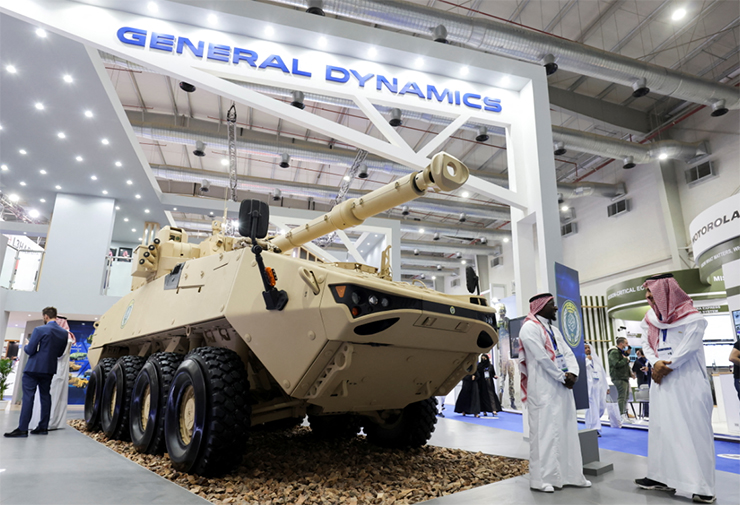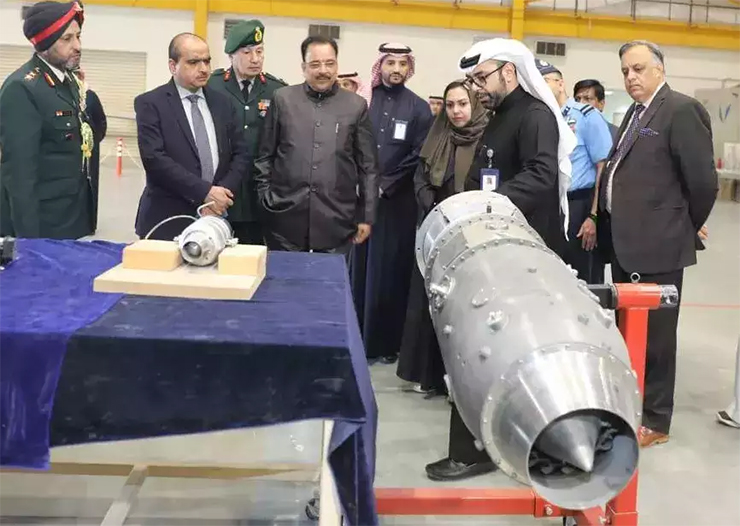The Saudi Defence Show 2024, which concluded on February 8, 2024, showcased strides made by the country towards its ambitious goal of spending 50 per cent of its military budget on domestic production by 2030, following in the footsteps of other rapidly growing economies that harnessed defence production for growth.
Saudi Defence Manufacturing
With about $70 billion spent on defence in the kingdom last year, achieving the aim would be a significant boost for Riyadh’s Vision 2030, a major goal of which is to reduce dependence on oil revenue by promoting non-oil exports.
Saudi officials at the WDS 2024 in Riyadh said the kingdom’s strategy focuses on nurturing local talent, with a strong focus on raising the profile of women in defence.
Many local companies like the National Company for Mechanical Systems (NCMS) and Jamla Holding showcased their products at the show.
NCMS showcased everything from the high-tech weaponry – the unmanned armoured vehicle turret, the Moreb 30, which can carry 30mm or 40mm canons that rapidly fire explosive shells – to less advanced but essential items including artillery shells currently in huge demand globally. Among other weapons, the company also makes glide bombs – fins and guidance systems that extend the range of conventional bombs.
A major goal of Saudi Arabia is to reduce dependence on oil revenue by promoting non-oil exports, like defence products

Jamla Holding, a Saudi-based company that owns engineering and manufacturing firm Atwad Industrial, gave a glimpse of the progress in military robots, such as their prototype unmanned “surveillance vehicle, designed, produced and engineered entirely in Saudi Arabia”. The vehicle, which has not yet been named, can carry 100 kg of supplies and reach speeds of 40 km per hour, traversing rough terrain for as long as 12 hours.
In the aerospace sector, Wahaj, a company formed seven years ago, makes highly complex, precision machined spare parts for the kingdom’s F-15, Hawk and Tornado fighter jets. Wahaj is also working on the Themis unmanned ground vehicle in cooperation with the UAE’s Edge defence company and Europe’s Milrem Robotics.
Increasing experience in innovative design and manufacturing in Saudi Arabia’s defence localisation strategy could open the door for exports if the experience of other nations is any guide.
The kingdom’s GAMI signed 11 co-operation agreements with leading international firms with a focus on the “localisation” of Saudi defence production
Business Generated at WDS
At the Saudi defence show, US firm Lockheed Martin signed a deal to localise production of the THAAD, or Terminal High Altitude Area Defence system which can engage targets at altitudes of up to 200 km into space.
The kingdom’s General Authority for Military Industries (Gami) has so far signed 11 co-operation agreements with leading international firms with a focus on the “localisation” of Saudi defence production, according to the authority’s governor, Ahmad Al Ohali. Besides enhancing the capabilities of armed forces branches, improve their combat efficiency, and contribute to the support and localisation of defence manufacturing.
The contracts included agreements with Rheinmetall Arabia Simulation and Training (RAST), South Africa’s HENSOLDT GEW, Spain’s Rheinmetall Expal, Bosnia Igman Company, Korea’s Poongsan Corporation, Qudra Industrial Company, Fahad International Company, and the National Company for Mechanical Systems.
The Saudi Arabian Military Industries (Sami), created in 2017, has set a target of 50 per cent of defence spending going to domestic producers by 2030, as part of the kingdom’s ambitious Vision 2030 plan to diversify the economy.
The MoS for Defence Ajay Bhatt and Saudi Arabia’s Defence Minister Prince Khalid bin Salman bin Abdulaziz Al-Saud discussed boosting bilateral defence cooperation, including joint military exercises and technology transfer
Boeing, the US aerospace giant, already has cooperation agreements with Sami and Gami, having supplied around 400 aircraft to Saudi Arabia, notably the F-15 Eagle, the backbone of the Royal Saudi Air Force.
Agreements were also announced during the show with Leonardo of Italy, one of the world’s largest defence companies. Aside from producing fixed-wing aircraft including the Alenia C-27J Spartan cargo plane and the M-346 trainer fighter jet, Leonardo has also worked on the F-35 stealth fighter and is developing tilt-rotor aircraft that can take off vertically like helicopters.

India at WDS
The Minister of State for Defence, Ajay Bhatt led the Indian delegation at the show. The MoS and Saudi Arabia’s Defence Minister Prince Khalid bin Salman bin Abdulaziz Al-Saud discuss boosting bilateral defence cooperation, including joint military exercises and technology transfer. Amid global tensions in West Asia, discussions focused on collaboration in training, technology, and expertise exchange.
Shri Ajay Bhatt also held talks with the Assistant Minister of Defence of Saudi Arabia Dr Khaled Al-Bayari, with whom he discussed ways to further strengthen the long-standing and multi-faceted defence cooperation between the two countries. The discussions centred around exploring avenues for collaboration in areas of mutual interest, including increasing the scope of joint training exercises, technology transfer and exchange of expertise.
In addition, the MoS also met with the Governor of GAMI, Ahmad Abdulaziz Al-Ohali. They discussed the way forward towards collaboration in varied areas of defence production, Research & Development, besides niche technologies. He also visited the pavilion of SAMI on the sidelines of WDS 2024.
Both sides, during discussions shared a deep understanding of the evolving security landscape and resolved to increase bilateral defence cooperation in multifarious sectors while also recognising the mutual benefits of a strong partnership in safeguarding regional security. Shri Ajay Bhatt expressed confidence that the India-Saudi Arabia partnership will continue to grow from strength to strength, contributing significantly to regional stability and global security.
Shri Ajay Bhatt also witnessed the signing of an MoU between, Munitions India Limited (MIL) and its local partner on the sidelines of WDS 2024. He also attended a Business-networking event with leading Indian and Saudi business personalities in Saudi Arabia.
India’s ‘Aatmanirbhar Bharat’ and Saudi Arabia’s ‘Vision 2030’ are national programmes that can be mutually beneficial to both sides
The Minister along with India’s ambassador to the Kingdom of Saudi Arabia, Dr Suhel Ajaz Khan, and Additional Secretary Anurag Bajpai also visited the BrahMos Pavilion, in a noteworthy demonstration of India’s growing prowess in defence technology and strategic diplomacy.
With its remarkable speed, accuracy, and adaptability, the BrahMos Cruise missile has changed the face of modern warfare. For countries looking to strengthen their military capabilities, it is a highly sought-after defensive asset due to its precise accuracy when striking targets from land, sea, and air platforms.
India’s ‘Aatmanirbhar Bharat’ and Saudi Arabia’s ‘Vision 2030’ are national programmes that can be mutually beneficial to both sides. Both initiatives prioritise technological advancements, indigenous capabilities and knowledge sharing. As highlighted by both sides, there is an immense potential for collaboration in these areas particularly in co-development and joint production of defence technologies.
–The writer is a political commentator based in New Delhi. He can be contacted on www.asadmirza.in. The views expressed are of the writer and do not necessarily reflect the views of Raksha Anirveda
-The writer is a New Delhi-based senior commentator on international and strategic affairs, environmental issues, an interfaith practitioner, and a media consultant. The views expressed are personal and do not necessarily carry the views of Raksha Anirveda














